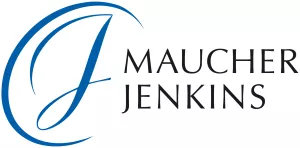- within Technology, Media, Telecoms, IT and Entertainment topic(s)
- with readers working within the Consumer Industries, Media & Information and Pharmaceuticals & BioTech industries
According to European and German trade mark law, trade marks are subject to an obligation to use. Anyone who has a certain sign protected for specific goods and services must actually use it for this purpose from a certain point in time. This obligation to use is intended to prevent the trade mark register from consisting mainly of inactive registrations. However, it only comes into effect after the so-called "grace period for use". This is five years. The point at which it begins to run is regulated differently depending on the type of trade mark (German trade mark, EU trade mark or international registration with designation of the EU or Germany)
In the following, we explain in which constellations the obligation to use or the grace period for use is relevant in trade mark law and how the latter is correctly determined.
I. Use and grace period in the German Trade Mark Act
The following overview focuses on the most important constellations in connection with the use of a trade mark, namely the case of infringement and the case of opposition or cancellation proceedings. Particular attention is paid here to the practical determination of the period of use, i.e. the question: For what period do I, as the trade mark owner, have to prove use before the Office or in court in the event of a dispute?
- The infringement case: Exclusion of claims for lack of use pursuant to Section 25 MarkenG
The trade mark grants its owner an exclusive right and claims in accordance with Section 14 MarkenG (in particular injunctive relief and damages) if this right is infringed. However, the trade mark must have been used sufficiently for these claims to be enforceable in the event of infringement.
Section 25 (1) MarkenG stipulates that a trademark owner can no longer assert its claims against third parties if the trademark has not been properly used within the last five years prior to the assertion of the claim. Put simply, anyone wishing to assert rights against third parties on the basis of their trade mark registration must have used it within the previous five years.
It is important to note that the five-year period in this case is determined by the date on which the claims are asserted. Five years are counted back from the date of assertion.
However, the obligation to use only applies if no opposition has been filed against the possibly infringed trade mark for at least five years at this point in time, or if the opposition proceedings have been terminated for five years (Section 25 (1) in conjunction with Section 26 (5) MarkenG). A further five-year period comes into play here, which initially has nothing to do with determining the period of use. Rather, the question is whether the trade mark has already been used or whether it is still in the so-called "grace period for use". If the time since which no further opposition can be filed against the trade mark is less than five years ago, no use must be proven in order to be able to proceed from the trade mark.
This illustrates the high practical relevance of the obligation to use and the associated grace period for use. In the first five years after an objection is no longer possible, the above-mentioned claims can be asserted without the opponent being able to raise the defence of lack of use. Anyone who has ever painstakingly collected proof of use from old catalogues, invoices, delivery notes and website presentations will know how much of a relief this grace period is. But the opposite is also true - as soon as the five years since the end of the opposition period/opposition proceedings have expired, every trade mark owner should document their use in order to be able to assert the exclusive rights arising from a registration quickly and easily in an emergency.
To summarise: Anyone wishing to proceed on the basis of their trade mark must be able to prove use for the five years prior to asserting the claim, unless the trade mark is still in the grace period for use.
- Use in opposition proceedings pursuant to Section 43
MarkenG
If the proprietor of an earlier trade mark files an opposition against a later trade mark, the proprietor may contest the use of the earlier trade mark (objection of non-use). If the grace period for use of the earlier trade mark has already expired, the opponent must provide evidence of use in response to the objection in order to substantiate use (Section 43 (1) MarkenG).
The calculation of the time limit is important in this context: The five years for which the opponent must prove use are not calculated from the end of the opposition period against his own trade mark (as in the first example for the claims for injunctive relief and damages). Instead, it is the five years prior to the filing or priority date of the later trade mark against which the opposition is directed.
Opposition to the later trade mark is therefore only justified if an identical or similar sign has been actively used in the five years prior to its application.
- Cancellation due to non-use pursuant to Section 49 (1)
sentence 1 MarkenG
A trade mark proprietor who does not use their trade mark for an uninterrupted period of five years after the date on which it can no longer be opposed is exposed to the risk of an application for cancellation due to revocation. As soon as the trade mark has been registered and any opposition proceedings have ended (Section 26 (5) MarkenG), there may be gaps in use, but these may never be longer than five years.
Background information: Before the Trademark Law Modernisation Act (MaMoG) came into force in 2019, the grace period for use began with the publication of the registration or - if an opposition was filed against the registration - at the time the opposition proceedings were concluded. Now, the grace period for use begins on the day from which no further opposition can be filed against the registration of a trade mark. This is either the day after the expiry of the opposition period or the date on which the decision that ended the opposition proceedings becomes final or the date on which the (last) opposition is withdrawn. This means that the calculation of the grace period for use of the opposing trade mark is in line with EU trade mark law
II. Use and grace period under the European Union Trade Mark Regulation
The calculation of the grace period for use in the EU served as a template for the current calculation in Germany (see above under "Background information"). The grace period for use begins with the registration of the EU trade mark and runs for five years.
The end of the opposition period or pending opposition proceedings (as in Germany) is irrelevant for EU trade marks, as EU trade marks are only registered after the opposition period or opposition proceedings have expired - before that, the trade mark is at the application stage. In Germany, the trade mark is registered immediately, irrespective of any oppositions. This leads to different terminology (application in the EU, registration in DE), but the relevant period of the grace period for use is the same. It only begins in both jurisdictions when no more oppositions are possible. In the EU, registration will then also take place, which is done earlier in Germany
III. International registration
The effect of a basic trade mark is extended to various countries via an international registration ("IR"). This is a bundle of national trade marks, not a uniform "global trade mark", as is the case with the EU trade mark for the EU.
Under the IR, both Germany and the Union can be designated as the area of application. The regulations regarding the grace periods for use for these designations from IR differ from the regulations for the national German trade mark and the EU trade mark described above. In the following, we show where the information on the start of the grace period can be found on the official websites (Madrid Monitor of WIPO, eSearch of EUIPO, DPMA Register).
1. DE from IR
In order to determine whether a German trade mark based on an IR is still within the grace period for use, the date of dispatch of the notification of the international registration pursuant to Rule 18 (1) (a) (iii) of the Common Regulations under the Madrid Agreement (MMA) or the Protocol to the Madrid Agreement (PMMA) is decisive. This notification is only sent once the extension of protection procedure has been completed, i.e. no further opposition is possible.
This is the date on which the DPMA notified WIPO that protection was granted in Germany. This date is displayed in the Madrid Monitor (https://www3.wipo.int/madrid/monitor/en/) under "Date of receipt by the International Bureau".
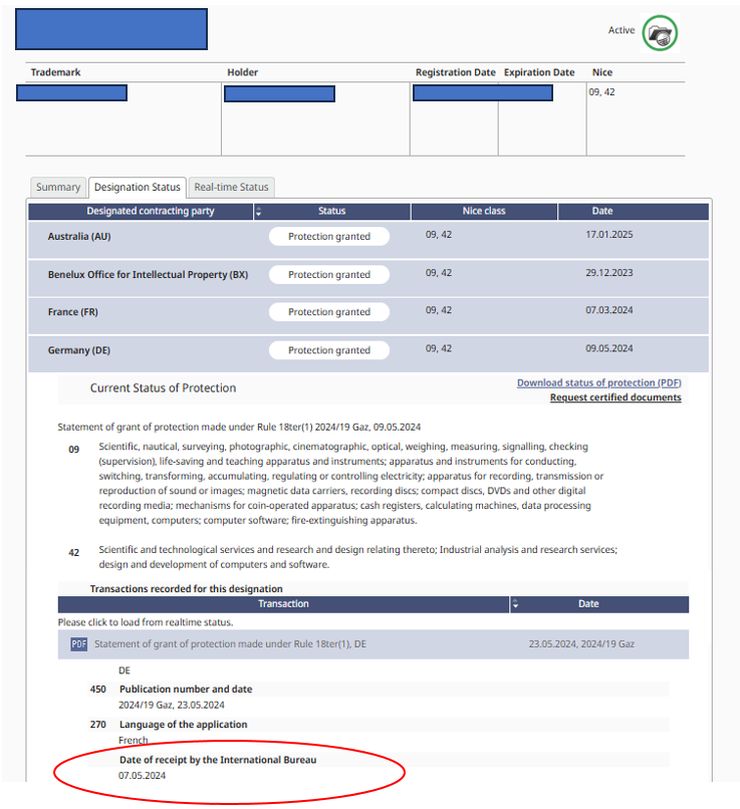
The representation of the same trade mark in the DPMA register is somewhat simpler. It expressly states: Start of the grace period for use:
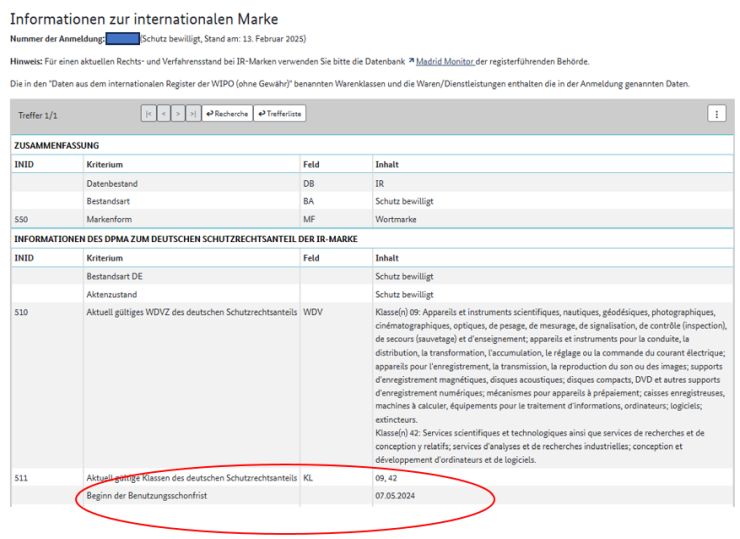
2. EU from IR
The second subsequent publication by the EUIPO takes place if the international registration remains (at least partially) protected for the European Union after all procedures have been completed. The date of the second publication triggers the five-year period for use.
In the EUIPO register under eSearch plus it looks like this:
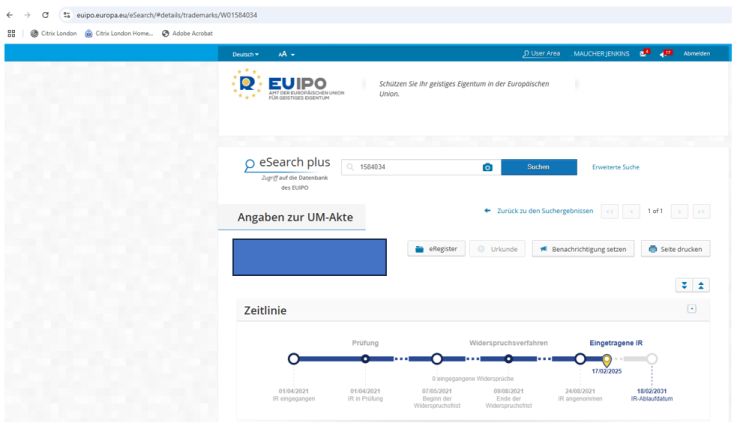
Scroll down to the "Publications" tab. Open the lower entry in section M.3.1.
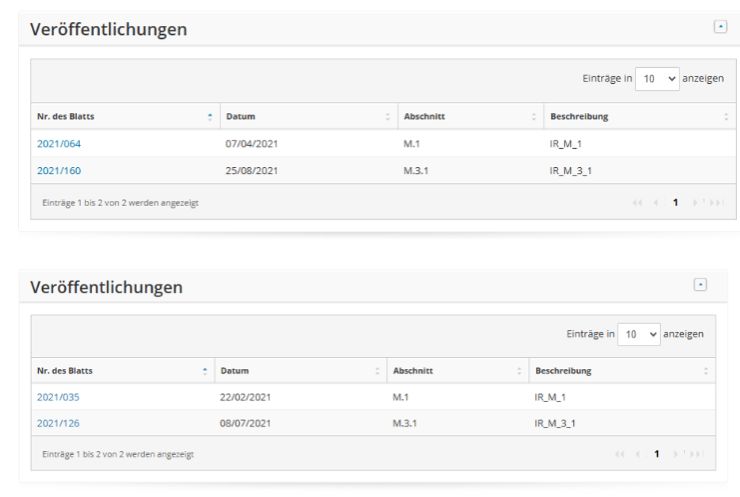
The entry with the number 450 marks the start of the grace period. In our example, this began on 25 August 2021 and therefore ends on 25 August 2026.
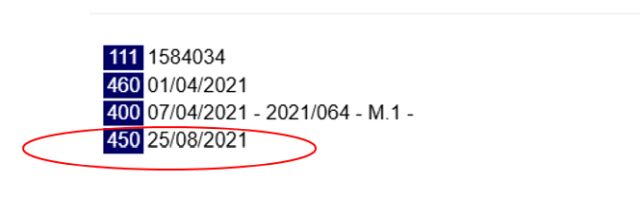
Summary:
European and German trade mark law assumes that a trade mark owner must use their trade mark from a certain point in time if they wish to derive rights from it. However, this obligation to use the trade mark only comes into effect after the five-year grace period, the specific calculation of which must take into account the characteristics of the respective type of trade mark. In summary, however, it can be said that it depends on when an opposition can no longer be filed against a trade mark or when opposition proceedings have been concluded.
If a trade mark is no longer used after the grace period, it is generally ready for cancellation. In opposition proceedings based on such a trade mark, the opponent could successfully raise the defence of non-use of the trade mark. However, it should be noted that the relevant 5-year period of use is calculated according to the application date of the trade mark against which the opposition is filed. The opponent's trade mark must have been used within the 5 years prior to the filing date of the contested trade mark. A "pure" registration right should therefore not be able to prohibit a new application.
Against this background, trade mark owners should ensure that they systematically collect and document their own trade mark use from the expiry of the grace period in order to be able to provide corresponding evidence in the event of a dispute. It should also be borne in mind that trade mark law assumes that a trade mark is to be used as it was entered in the register. Amendments to the trade mark could therefore lead to a rejection of the use of the originally registered sign in the event of a dispute. It may be necessary to re-register the trade mark if the distance to the original trade mark is too great. The obligation to use the trade mark under trade mark law therefore also has a major influence on your own trade mark strategy.
The content of this article is intended to provide a general guide to the subject matter. Specialist advice should be sought about your specific circumstances.

